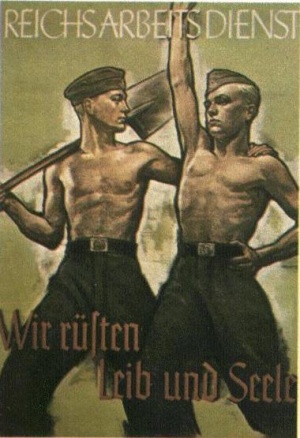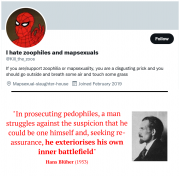One of our staff members is contributing considerably to a News Archiving service at Mu. Any well educated (Masters, PhD or above) users who wish to make comments on news sites, please contact Jim Burton directly rather than using this list, and we can work on maximising view count.
Debate Guide: Self-loathing hatred: Difference between revisions
The Admins (talk | contribs) |
The Admins (talk | contribs) |
||
| Line 32: | Line 32: | ||
File:Selfown.png|David Abbott (cop) | File:Selfown.png|David Abbott (cop) | ||
File:Anime2.png|Peter Newell (child advocate) | File:Anime2.png|Peter Newell (child advocate) | ||
File:Anime.jpeg|Peter Bright (gamergater) | File:Anime.jpeg|Peter Bright (anti - gamergater) | ||
File:Battisson.png|Cameron Battisson (vigilante) | File:Battisson.png|Cameron Battisson (vigilante) | ||
File:UPIUNICEF.png|Jozef Verbeek (UNICEF) | File:UPIUNICEF.png|Jozef Verbeek (UNICEF) | ||
Revision as of 01:48, 12 September 2022
- In Freudian terms, the defense mechanism of Reaction Formation.

Projection, guilt, exteriorisation and self-loathing are all important parts of the violently anti-pedophile psyche.
One example of the need to draw lines and attack a minority comes from Giles[1]:
Part of the problem is that heterosexual male desire often sits on a knife between a preference for neonate facial features in women (clear skin, large eyes, high cheekbones) and an intense revulsion toward paedophilia. It could be argued that the ferocity of assaults on convicted (child) sex offenders and the mob violence often enacted against rehabilitating child abusers are driven partly by the need for heterosexual men to have clear boundaries between what is acceptable sexual desire (i.e., the youngest, healthiest, fertile female) and what is not (legally protected children). If a subgroup of men can be clearly identified and labelled, it reduces the uncertainty surrounding their own borderline desire for young-looking women.
And Bluher (1953):
In prosecuting pedophiles, a man struggles against the suspicion that he could be one himself and, seeking reassurance, he exteriorizes his own inner battlefield.
Jim Gamble (former CEOP):
They (paedophile hunter groups) attract people with domestic abuse records and coercive control. They give people the opportunity to reinvent themselves as a good person and create this status, to build a Facebook or a Twitter following. [...] It makes them feel good about who they are and allows them to mask some of their other behaviors.[2]
If the history of art is to be believed, it would appear that child nudes are widely appreciated and idolized aesthetically. It is easy to understand how widely these physical attractions toward the sensuality and bodies of prepubescent children must be felt, and the guilt this must cause in cultures disposed towards demonizing or denying it. Through reaction formation, we externalize the resultant desire to distance ourselves from these attractions by attacking others who fit the stereotype.
This tendency is particularly pronounced in individuals who - for example, attack the "pedophile other" as "wanting to rape babies". The imputation of such extreme motives derives from a need to distance the "other" from one's own strong erotic attraction to pubescent girls - hebephilia, or younger. Further, a Pseudoexclusive Teleiophile (who likely has a hebephilic attraction of some sort) will often sharply accuse others of "thinking it's ok to... (unlawful sex/other activity with children)" or similar. When used in an isolated and emotional manner, this is seen as a "tell" for psychological repression or conscious control of hebephilic interest. This is because they are projecting unto the "other", an acceptance of condemned desires - failure to police the internal moral boundaries they are struggling with themselves.
History of Homosexuality

Reaction formation is better known as a historical feature of gay culture, in societies where homosexuality is widely condemned. In addition to the well-documented history of homosexuality and pederasty in the German far-right movement, present day trends also shed light on this psychological mechanism. For example, insistently "masculine", "straight" affected forms of male homosexuality continue to exist alongside and sometimes in opposition to its camp affected varieties. While these definitively masculine identities may have entered gay culture because of a mixture of self-hate and fetishization, intensely masculine homosexuality is now appreciated in and of itself. Clearer examples can be observed in the reactions of questioning gay or bisexual men who have moved from a "straight" lifestyle, some of whom will verbally or physically attack, blame and deny after engaging in gay sex "acts" they can not reconcile with their assumed sexual identity. Plethysmograph studies in which decidedly homophobic men were more than twice as likely to be aroused by gay stimuli as the nonhomophobic men, would appear to back this up.[3]
Lolicon-MAP Equivalence Debate
The Lolicon-MAP Equivalence Debate is a more contemporary example of reaction-formation in the form of distancing. It relates to the need for "Lolicons" (avid consumers of drawn female child erotica) to express hate for MAPs, minors, and deny that they are attracted to minors.
Gallery of self-owns
-
David Abbott (cop)
-
Peter Newell (child advocate)
-
Peter Bright (anti - gamergater)
-
Cameron Battisson (vigilante)
-
Jozef Verbeek (UNICEF)
References
- ↑ Giles, D. (2003) Media Psychology, Lawrence Erlbaum
- ↑ Jim Gamble
- ↑ Adams HE, Wright LW Jr, Lohr BA. Is homophobia associated with homosexual arousal?. J Abnorm Psychol. 1996 Aug;105(3):440-5.




